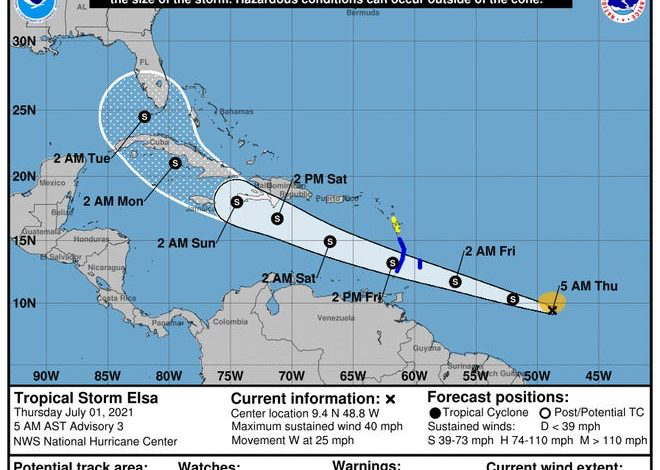By The Associated Press
Troy Warren for CNT
Elsa strengthened into the first hurricane of the Atlantic season on Friday as it battered the eastern Caribbean, where officials closed schools, businesses and airports, and it appeared headed eventually for Florida.
The Category 1 storm unleashed heavy rains and winds on Barbados and then on St. Vincent and the Grenadines, which are struggling to recover from recent massive volcanic eruptions.
Elsa was located about 5 miles north of St. Vincent and was moving west-northwest at 29 mph. It had maximum sustained winds of 75 mph, according to the National Hurricane Center in Miami.
“That level of sustained wind can blow down a lot of buildings and cause a lot of damage,” said St. Vincent Prime Minister Ralph Gonsalves. “I am pleading with you. Let us not take this hurricane lightly. This is not the time to play the fool.”
A hurricane warning was in effect for St. Lucia, St. Vincent and the Grenadines, as well as southern Haiti from the capital, Port-au-Prince, to the southern border with the Dominican Republic.
The long-term track showed the fast-moving storm rolling toward Hispaniola, the island shared by Haiti and the Dominican Republic, as a hurricane before weakening back to tropical storm force and potentially heading to Florida by early Tuesday.
Authorities opened dozens of shelters in St. Vincent and urged people to evacuate if they lived near a valley, given the threat of flash flooding, mudslides and lahars, especially in the northern part of the island where La Soufrière volcano is located.
“Do not wait until it’s too late to go to a shelter,” Gonsalves said.
He said 94 shelters are open, a smaller number than in previous years because some 2,000 people remain in other shelters following massive volcanic eruptions that began in early April.
A hurricane watch was issued for Jamaica and the south coast of the Dominican Republic from Punta Palenque to the border with Haiti.
Elsa is the earliest fifth-named storm on record, beating out last year’s Eduardo which formed on July 6, according to Colorado State University hurricane researcher Phil Klotzbach. He also noted that it’s the farthest east that a hurricane has formed this early in the tropical Atlantic since 1933. The 1991-2020 average date for the first Atlantic hurricane formation is mid-August.
The storm was forecast to bring 3 to 6 inches of rain with maximum totals of 10 inches on Friday across the Windward and southern Leeward Islands. The rain could unleash isolated flash flooding and mudslides.
NOAA predicted 2021 would be another above-average hurricane season but nowhere near 2020′s record-breaking status.
The National Oceanic and Atmospheric Administration is predicting another above-normal Atlantic hurricane season. Forecasters predict a 60% chance of an above-normal season, a 30% chance of a near-normal season and a 10% chance of a below-normal season.
However, experts do not anticipate the historic level of storm activity seen in 2020.
For 2021, a likely range of 13 to 20 named storms (winds of 39 mph or higher), of which six to 10 could become hurricanes (winds of 74 mph or higher), including three to five major hurricanes (categories three to five, with winds of 111 mph or higher) is expected.
The Atlantic hurricane season extends from June 1 through Nov. 30.
The Atlanta Journal-Constitution’s Tim Darnell contributed to this report.
In Other NEWS



































